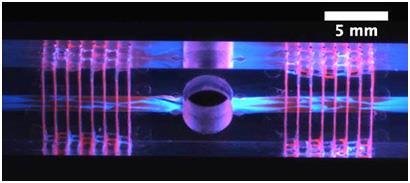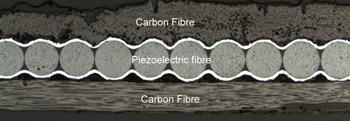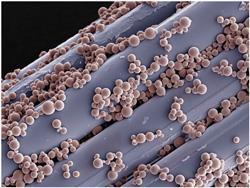A new breed of aircraft built from lightweight carbon composites is taking flight. But are these materials all they're cracked up to be, asks Hayley Birch
A new breed of aircraft built from lightweight carbon composites is taking flight. But are these materials all they’re cracked up to be, asks Hayley Birch

Travelling on an aeroplane subjects the body to unusual stresses. Besides the psychological trauma of being 10km above solid ground, the atmosphere inside a jet plane - although partly pressurised - is akin to being half way up Mount Kilimanjaro; low enough to allow feet and legs to swell and to increase the risk of deep vein thrombosis. So why not make things a bit more comfortable by raising the pressure to something approaching sea level? A straightforward solution, you might think. But it’s not that simple - such high cabin pressure would create too much stress for a conventional aluminium fuselage.
Using composites, however, Boeing appears to have solved the problem. The company’s new Dreamliner aircraft operate at slightly higher cabin pressures by virtue of their marginally thicker fuselages, made largely from carbon fibre reinforced polymer (CFRP). By volume, each plane is 80 per cent composite materials - these extend to almost every part of the plane bar the engines. Despite the bulkier fuselage, there’s still a weight saving to be made, thus demonstrating two of the major advantages of composites: strength and lightness.
Weaving carbon threads

UK chemist Paul Weaver, who specialises in developing lightweight structures at the University of Bristol’s Advanced Composites Centre for Innovation and Science (ACCIS) walked on Boeing’s first Dreamliner three years ago. ’Boeing realised that carbon fibre is 40 per cent lighter than aluminium,’ he says. ’So they made the fuselage thicker and sacrificed a bit of the weight saving that they would have had over aluminium. But they’ve ended up with a lighter solution and higher internal pressure which means better cabin comfort.’ Not only that, but the lighter structure means lower fuel burn, saving 20 per cent compared to other planes of its size.
So it sounds like it’s all over for aluminium. Well, perhaps not just yet. Aircraft component manufacturers are facing what are tactfully referred to in the industry as ’challenges’ in working with composites. In addressing these challenges, new manufacturing processes are emerging as well as smart structures that can change their properties and even mimic biological functions like healing to repair themselves.
According to Weaver, however, the most urgent problem facing industry right now is manufacturing enough carbon fibre to meet the demands of aerospace giants like Boeing and Airbus. CFRP is essentially very thin fibres of carbon embedded in an epoxy resin matrix. During component manufacture for aerospace applications, many layers of carbon fibre are built up and then cooked under pressure in an autoclave to cure and harden the constituents of the matrix. The underlying chemical reaction is a copolymerisation between short polymer chains of resin and monomers of a hardening chemical. ’Prepreg’ carbon fibre, which comes on a roll and is already impregnated with resin, is often used to speed up the process.
There is no getting around the fact that making aircraft components from composites is slower and more labour intensive than making them from aluminium. A pattern and then a mould have to be produced before the first components emerge. As Weaver notes, composite components have to be designed with a larger margin for error, owing to the different properties associated with each of the fibre and matrix materials. Accurately predicting the collective properties of the finished material is tricky and as a result, manufacturing tolerances for composites tend to be larger than for aluminium.
The laying of prepreg in carbon fibres can be carried out by a machine, but achieving optimum stiffness and resistance to buckling means precisely tailoring the directions in which the fibres are laid. Weaver’s team has developed a technology based on a modified embroidery machine that stitches fibres into place with threads that are later dissolved. ’When we dissolve those stitches out, we’re left with the orientation of the carbon fibre where we want it, and then we can put resin film on top, then another layer of carbon fibre however we want it,’ Weaver explains. Unsurprisingly, the approach is painfully slow and creates defects. Plus, dissolving the stitches adds a further layer of complication to the already arduous process of making CFRP. But one of Weaver’s co-workers, Byung Chul Kin, has recently come up with an improved and virtually defect-free machine that has just been granted a patent. Weaver says he expects to be using it to make A350s - Airbus’s 53 per cent composite jetliners - in the next few years.
Still, industrial curing processes are time- and energy-consuming. As, Brian Smith, director of composites for Boeing Research & Technology, explains, most CFRP composites currently produced for the aerospace industry are cured in autoclaves at around 180?C. ’Recent advances in the ability to cure outside of the autoclave look promising,’ he says. Companies like Quickstep in Australia, whose customers include Airbus and the US Department of Defence, claim to be able to make impressive energy savings of up to 85 per cent by using out-of-autoclave technologies. The Quickstep process uses a curing chamber containing fluid that rapidly transfers heat to the material and requires shorter heat cycles. This has the added advantage of reducing the curing time. Other methods with potential include electron beam, microwave and infrared curing.
Cracks are showing
Unfortunately, owing to their unpredictable properties, repairing composite materials is no more straightforward than making them. Repairing aluminium is a cinch, by comparison, says Weaver. ’It’s the same material in all directions,’ he observes. ’But in a composite, the weave is different in different parts, so repairing it is very difficult. I’m not aware of any particularly elegant repair methods yet.’
Currently, the lack of straightforward repair strategies for composites places a massive financial burden on the aerospace industry, with some estimates suggesting that as the contribution of composite materials to the overall structure of an aircraft increases, the maintenance costs begin to approach or even exceed the fuel costs. As Duncan Wass - another of Weaver’s colleagues - points out, by this logic the cost must be ’absolutely vast’. In another department at the University of Bristol, Wass, a chemist with a background in petrochemicals and catalysis, is working on a rather intriguing solution to the problem - composite materials that can heal themselves.

It might sound like something from the realms of science fiction, but Wass’s approach to fixing damaged aeroplane wings follows biology’s example. ’Our inspiration for this is basically the human body,’ he explains. ’If you get cut, the wound bleeds, then it scabs and heals. We’re trying to make aeroplane wings that do the same thing.’ In his team’s self-healing system, the ’cut’ is a small crack caused by damage to the composite structure. This ruptures tiny microcapsules embedded in the material, releasing healing agents.
A forthcoming paper1 describes how the team use a scandium-based catalyst as a healing ’initiator’ - akin to the inflammatory response in biological systems - to drive polymerisation of epoxy monomers contained within the capsules. The aim is to fill the crack before it has a chance to grow. As in the body, the effects are not instantaneous, but Wass claims his self-healing materials can regain close to 80 per cent of their original performance within 48 hours.

At the University of Illinois in Urbana-Champaign, US, a team of self-healing materials experts led by Scott White and Nancy Sottos has been working on similar capsule-based healing systems for years. In fact, they have devoted a whole series of publications to one particular system involving dicyclopentadiene-containing microcapsules and a ruthenium-based catalyst, achieving healing efficiencies around the 80 per cent mark.2 The trouble with these capsule-based approaches is that the capacity for healing agents within the capsules is limited and after several rounds of healing their store becomes depleted. Thus, self-healers at Urbana-Champaign and Bristol are also exploring other approaches; ones that take bioinspired materials to a whole other level.
In 2010, Sottos’s group reported embedding a so-called ’vascular’ system into an epoxy matrix to heal cracks in the material.3 This vascular approach incorporates channels designed to mimic blood vessels in the human circulatory system. They injected epoxy resin (the healing agent) and an amidoamine hardening agent into alternative layers of channels, so that the two would only mix if a crack occurred that severed both. ’We found that we could get repeated healing even though we damaged the network,’ says Sottos. Their samples healed through 13 rounds of damage and healing, although by the final rounds, healing efficiency was below 50 per cent. They also suggest they could extend the healing capacity of their materials even further by actively pumping in healing agents when they are damaged.
Smart structures
Sensor systems already exist that are capable of self-diagnosing and reporting damage to aircraft materials. Also within the bounds of possibility are energy-harvesting materials that could turn wasted energy from turbulence into useful electricity, as well as bi-stable, morphing composites that snap from one shape to another to influence lift and drag - traditional aircraft materials could not withstand such strains. Chris Bowen and colleagues at the University of Bath in the UK describe using standard carbon fibre manufacturing techniques and piezoelectric actuators to control the shape of wing structures.4 During manufacture, they layered up carbon fibre sheets non-symmetrically to produce composites that would snap between the two stable states.

The long term view

But according to Sottos, it could be a long time before self-healing materials see anything resembling an aeroplane. ’New materials in the aerospace industry have a very long life cycle,’ she says. ’It takes a long time to get them on something that flies human beings because of the safety issues, so the composites that are in Airbus A350s or Boeing’s Dreamliner, those are composites that were developed 20 to 30 years ago.’ Military planes or drones may be the first candidates for testing self-healing materials.
Perry Cohn, composites engineering director at Alpha Composites in Buckingham, UK, says self-healing composites are ’blue sky stuff’, although he admits that better repair strategies are needed - especially for repairing materials that are damaged in the field. ’One of the main problems with repairing composite structures until now has been that if the main component is made in an oven at over 120?C, how do you repair that in the field?’ Which brings us back to the central problem with the autoclave process. Cohn says low temperature resins are an area of fervent research within composites and resins already exist that will cure at 50 or 60?C. Thus, future composite manufacturing processes should combine low temperature - and low energy - curing processes with better prospects for repair.
From Cohn’s point of view, there isn’t so much a problem with the process for making composites as with the engineers involved in it, many of whom still haven’t come to terms with the different design philosophy needed for composites and are still taking a ’metals approach’. It’s a more labour intensive process, he says, but offering opportunities unparalleled by metals to tailor every aspect of the material. Whereas an aluminium component has to be machined from the existing metal, the process for producing a composite material is part and parcel of the component manufacturing process. And if designed properly, argues Cohn, each component should be fully optimised. ’The secret to designing composites is just to design composites and not to make metal components out of composites,’ he says. ’There are properties of composite materials that are phenomenal, but you have to use a different mindset when designing them.’
Worth the effort
The benefits of using composites far outweigh the drawbacks, according to Cohn. And if there were any doubts about whether such a tortuous manufacturing process could make the numbers add up, Weaver looks at them from an airline’s point of view. ’Why are we using composites? Because the weight saving is so enormous. Which means lower ongoing costs due to lower fuel burn. So initially, they may be more expensive than aluminium, but you have to factor in the lifetime cost of 20 years of use every day.’ Because they’re lighter materials, he adds, there’s also the potential to make bigger planes and put more passengers on them. One way or another, they’ll make their money back.
Hayley Birch is a freelance science writer and editor based in Bristol, UK
References
1 T S Coope et al, Adv. Func. Mat., 2011, in press.
2 B J Blaiszik et al, Annu. Rev. Mater. Res., 2010, 40, 179 (DOI: 10.1146/annurev-matsci-070909-104532
3 A R Hamilton, N R Sottos and S R White, Adv. Mat., 2010, 22, 5159 (DOI: 10.1002/adma.201002561)
4 Bowen et al, J. Intell. Mater. Syst. Struct. 2007, 18, 89 (DOI: 10.1177/1045389X07064459)






No comments yet